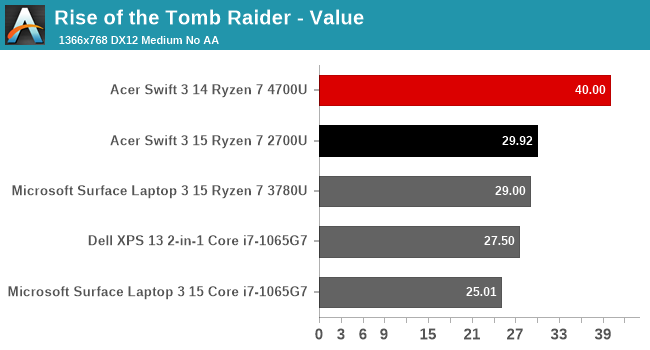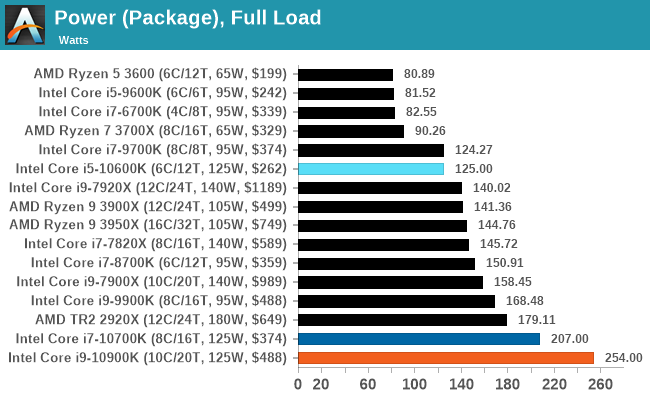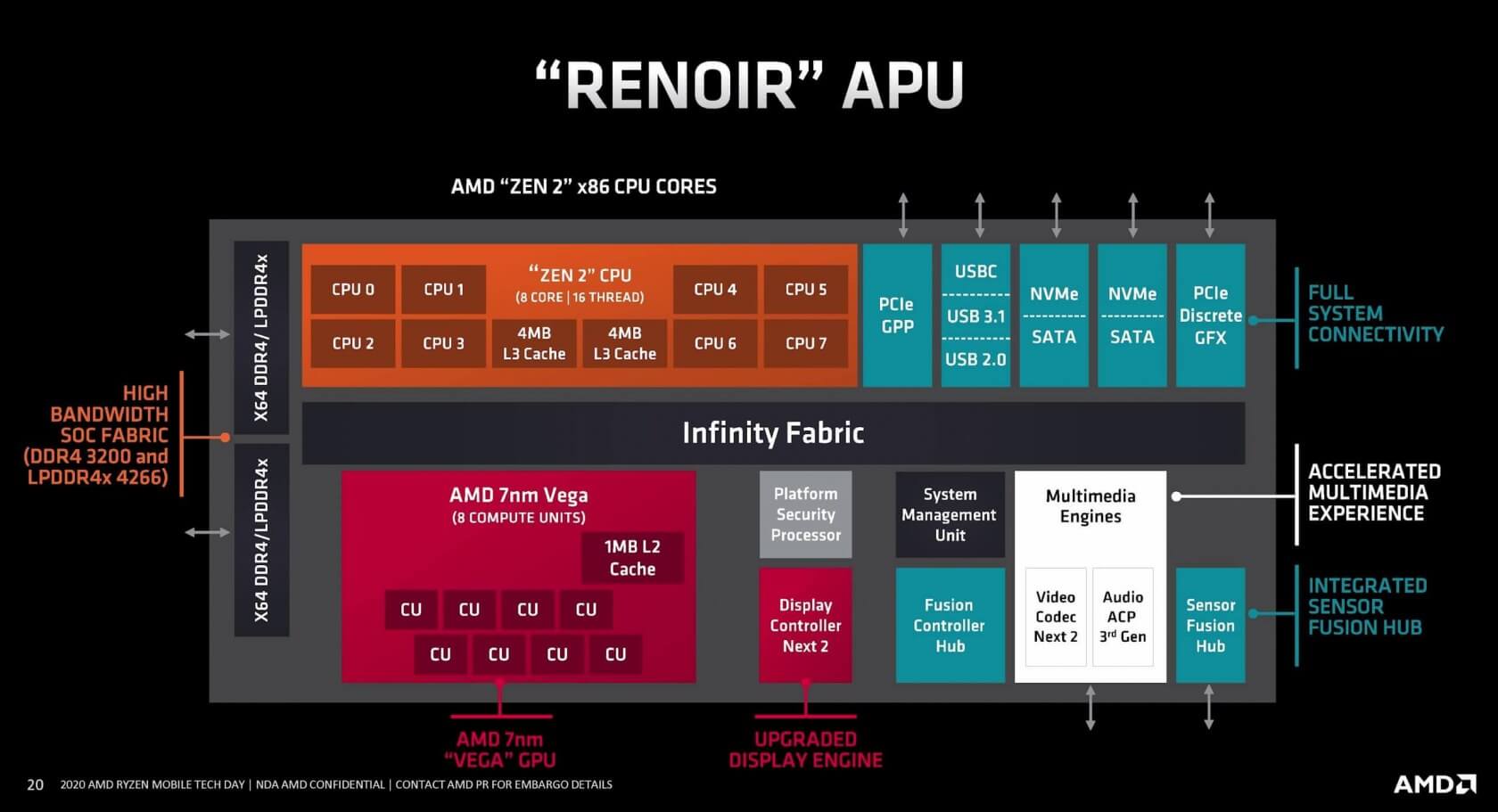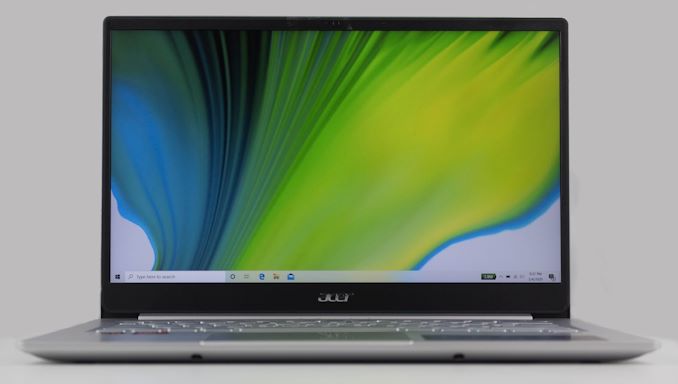This is our first review of AMD's Ryzen Mobile 4000 U-series processors, the low power variants intended for slim, light, ultraportable laptops. Our exploration starts with the mid-range Ryzen 5 4500U, a 6 core, 6 thread part with 6 Vega GPU units. All with a default TDP of 15W.
You are using an out of date browser. It may not display this or other websites correctly.
You should upgrade or use an alternative browser.
You should upgrade or use an alternative browser.
AMD Ryzen 5 4500U Review: Mid-Range Zen 2 Beats Intel's Best
- Thread starter Scorpus
- Start date
Shadowboxer
Posts: 2,074 +1,655
Great review, great chips from AMD. It’s the first time in a very very long time that AMD isn’t just making bargain basement laptop stuff.
However your civ test is flawed. It’s been proven that weaker CPUs give higher fps in that game because the turns take longer to complete and when a turn is processing nothing happens on screen. Gamers nexus has covered this already. No one needs high fps in civ, if you are a proper civ player like me then turn completion time is everything. Please stop using average fps in civ as it’s misleading.
However your civ test is flawed. It’s been proven that weaker CPUs give higher fps in that game because the turns take longer to complete and when a turn is processing nothing happens on screen. Gamers nexus has covered this already. No one needs high fps in civ, if you are a proper civ player like me then turn completion time is everything. Please stop using average fps in civ as it’s misleading.
Now, when and from who can I buy this thing with components that are not garbage...
I'm waiting to see one of these turn up in a Ms surface pro and I may grab one.
General Ryzen
Posts: 12 +6
Now, when and from who can I buy this thing with components that are not garbage...
Agree, Lenovo's quality has been going downhill for awhile now.
Now that Costco (already out of stock) has started selling the Ryzen HP Envy x360, I'd be interested in an update to Techspot's article on the first Ryzen mobile laptop.
Last edited:
I've been eyeing the new IdeaPad notebooks from Lenovo, but from the looks of it, they won't be the holy grail of budget laptops. At least here in the Czech Republic, the configurations you can get (for around 500 euro) are lacking here or there. For example, it's nigh impossible to get a Ryzen 5 4500u with 16GB of RAM (here in the Czech Rep.). For that you have to shell out more for the higher tier Ryzen CPUs (or Intel CPUs). Also the screen (at least on paper) seems to be a huge letdown :S
I own a 4 year old IdeaPad that came with an i5-5200U and 8GB of RAM, and while it works pretty well, it'd be so nice to upgrade to this Ryzen model.
I own a 4 year old IdeaPad that came with an i5-5200U and 8GB of RAM, and while it works pretty well, it'd be so nice to upgrade to this Ryzen model.
neogodless
Posts: 8 +10
I'm impressed by the end results but I find the naming convention completely mystifying. It's a Zen 2 based, 3rd gen Ryzen, with 6 cores, called a 4000 APU but under the Ryzen 3000 brand??? It's like numeric version of alphabet soup.
I think if you're technical enough to know it's Zen 2, you know the rest. As a consumer buying a laptop, you could be comparing the Ryzen 3750H and 3500U with the new Ryzen 4800H and 4500U. To be sure, they probably screwed up a while back when they released the first mobile Ryzen mobile APUs and named them 2200/2400. No going back now.
But in some fairness, the Ryzen 4000 series is "more advanced" than the Ryzen 3000 series in general. Same Zen 2 hardware which is technically (at least) the third generation of Ryzen, but they've really squeezed efficiency out of these, improving upon the Ryzen 3000 desktop chips in that respect. But yeah, it could be less confusing
Ludak021
Posts: 775 +590
All I care for is gaming and this isn't even close to intel. I'd make a title "AMD once again fails to make a gaming CPU"
That's if I pretended to be an intel fanboi like the author of this article is an AMD fanboi. But w/e. All I see is intel 14nm 10xxx beats AMD 7nm....Intel to introduce good bye to AMD with it's own 7nm in 2021.
That's if I pretended to be an intel fanboi like the author of this article is an AMD fanboi. But w/e. All I see is intel 14nm 10xxx beats AMD 7nm....Intel to introduce good bye to AMD with it's own 7nm in 2021.
Which would be misleading, because in the 4 games tested, the 26 W Ryzen outperformed better than the other 25W packages, with the exception being the Core i7-1065G7 + MX250 combination in GTAV.I'd make a title "AMD once again fails to make a gaming CPU"
Whatever one wishes to think about AMD or Intel's products, at the end of the day, specifications and performance figures speak for themselves.All I see is intel 14nm 10xxx beats AMD 7nm
Core i7-1065G7 vs Ryzen 5 4500U
Cores: 4 vs 6
Threads: 8 vs 6
Base clock: 1.3 vs 2.3 GHz
Boost: 3.5/3.9 vs 4.0 GHz
L3 cache: 6 MB vs 11 MB
In a similar power configurations, one can see how this pans out:


Intel's 10 nm process node may well be superior to TSMC's N7, but the end product (I.e. the 1065G7) is clearly not better than the opposition (the 4500U) in these tests, bar the single Acrobat test at 25/26W - it could, of course, be better in other tests and configurations, but the above should be sufficient evidence to anyone that there is simply nothing wrong the 4500U and that the article's title is perfectly fair.
Intel claims its 10nm having greater density than TSMC 7nmAMD should basically kiss TSMC legs for this sweet process.
They're in the article; it shows the same outcome, when you look at the results for the tests using integrated graphics only. However, if you want further data, you may have to wait a while as there aren't many 4500U reviews out there. Anandtech have done the 4700U:Those are irrelevant benchamrks. Show me gaming.

From the specs alone, one would expect the 4700U to outperform the 1065G7:
Core i7-1065G7 vs Ryzen 5 4700U
Cores: 4 vs 8
Threads: 8 vs 8
Base clock: 1.3 vs 2.0 GHz
Boost: 3.5/3.9 vs 4.1 GHz
L3 cache: 6 MB vs 12 MB
But the 2700U performs, in that particular test, just as well as the 1065G7, and the specs are comparable too:
Core i7-1065G7 vs Ryzen 5 2700U:
Cores: 4 vs 4
Threads: 8 vs 8
Base clock: 1.3 vs 2.2
Boost: 3.5/3.9 vs 3.8
L3 cache: 6 MB vs 4 MB
Yes, they are - the Core i7-1065G7 is on their 10nm node:Also, intel is not doing 10nm, you are out of loop. They moved to 7nm at TSMC

Product Specifications
quick reference guide including specifications, features, pricing, compatibility, design documentation, ordering codes, spec codes and more.
Who are you referring to with 'They' - AMD or Intel?
Intel were claiming approximately 100 million transistors per square mm, 3 years ago:Intel claims its 10nm having greater density than TSMC 7nm
They're typically don't state transistor count for their products, so unless Intel changes tack with the forthcoming 10 nm lineup, all one will be able to do is make some educated guesses. As things currently stand, Renoir is roughly 62 million transistors per square mm; Matisse is just over 50; Pinnacle Ridge around 25.
I'd expect Intel 10 nm node to be at least as dense as Renoir, but possibly scaled back from the initial targets - they aimed for an enormous increase in density over their original 14 nm node, which has almost certainly been part of the issues they've been experiencing with the newer process.
Ludak021
Posts: 775 +590
To continue my fanboi narrative with lectures:
10nm for mobile (already done, it exists, it works, quite well actually contrary to what even Intel believed) https://www.digitaltrends.com/computing/intel-10nm-not-the-best-node/
and 7nm will be 2021 meteor lake desktop
also:
and do keep in mind that current desktop intel 14nm is trading blows with amd 7nm in every aspect. And is still better in games, which more people use their computer for than handbrake or excel or dumb stuff that is fast on calculator from 15 years ago. I don't know why people even benchmark those. Before Ryzen came, they did not. Must be AMD insisting on those to look good. (+sarcasm)
(+sarcasm)
have a nice day.
PS. when I said "not doing 10nm" I meant for desktop CPU. My bad for not clarifying that, excuse me.
10nm for mobile (already done, it exists, it works, quite well actually contrary to what even Intel believed) https://www.digitaltrends.com/computing/intel-10nm-not-the-best-node/
and 7nm will be 2021 meteor lake desktop
also:
and do keep in mind that current desktop intel 14nm is trading blows with amd 7nm in every aspect. And is still better in games, which more people use their computer for than handbrake or excel or dumb stuff that is fast on calculator from 15 years ago. I don't know why people even benchmark those. Before Ryzen came, they did not. Must be AMD insisting on those to look good.
have a nice day.
PS. when I said "not doing 10nm" I meant for desktop CPU. My bad for not clarifying that, excuse me.
pcnthuziast
Posts: 1,595 +1,409
I'd love to have a Zen 2 cpu in my laptop, but I'm pretty happy with the intel based budget gamer I just picked up at MicroCenter. It has the 9300h which is a 45w cpu and it's pretty snappy. It performs very near to my desktop which has a 6700k. I'm sure these amd chips smoke it easily, but for my uses which are mostly gaming, it is plenty of cpu to feed the 1650 in the laptop.
Ludak021
Posts: 775 +590
That's the thing with 80% of these fast cpu tests. There is only one thing to test: is it snappy or not?! If something is a as fast as blink of an eye on every cpu - why test that? Or better yet, why make that test into something with no actual real world scenario use to make it last longer so you can measure more of it? For instance 7zip. Sure I use it. once per day on average. It lasts, idk, it's almost instant on any cpu.
I mean, it's about as relevant a test as testing an operation on windows calculator and see which CPU does it faster.
I mean, it's about as relevant a test as testing an operation on windows calculator and see which CPU does it faster.
There's no deny that Intel's 14 nm process node (including 14+ and 14++), along with the original Broadwell architecture have both been superb - after all, they've lasted 6 years, going from the i7-5775C (4C, 8T, 3.7 GHz max clock) to the i9-10900K (10C, 20T, 5.3 GHz max clock).do keep in mind that current desktop intel 14nm is trading blows with amd 7nm in every aspect.
But it's worth nothing that 14nm and 7nm don't really mean anything - they're just marketing names for the nodes, as nothing about either of them is actually 14 or 7 nm:
Intel 14nm vs TSMC N7
Fin pitch = 42 nm vs 30 nm
Fin width = 8 nm vs 6 nm
Fin height = 42 nm vs 52 nm
Gate pitch = 70 nm vs 64 nm
Metal pitch = 52 nm vs 40 nm
SRAM bitcell size = 0.0499 µm² vs 0.027 µm²
Intel didn't alter those figures much during the + and ++ revisions, but there was significant improvement with operating current and power dissipation, increasing the former by over 35% and the decreasing the latter by over 50% (comparing ++ to the original). Not that they wanted to, of course, but it was a necessity, bore out the 10nm issues.
However, the overall architecture design of Broadwell-to-Comet Lake is broaching its fundamental design limits. For example, Anandtech tested the core-to-core latency (normally a strength of Intel's chips) with the 10900K and found a bigger than expected increase in latency, going from 8 cores to 10. They also found, along with ourselves, that under full load, the PL2 draw is enormous:

It's impressive that the chips can withstand this heat, but it's the price that must be paid in order to hit the clock speeds that it does. And, of course, without these clocks, the latest Core processors just wouldn't have the gaming advantage that they do (regardless of the size of the advantage).
But let's stick to purpose of this particular review and your criticism that it doesn't perform as well as Intel in games - the 4500U test laptop had no discrete GPU, so it's not a fair direct comparison to include these values, in addressing the criticism. Why? Well, look at the following results:

Note the difference in the i7-1064G7 results, at 15W and at 15W with an MX250 - the inclusion of the discrete GPU more than doubles the average frame rate. Therefore, it only makes sense to compare the 4500U to 1065G7 when they're using the integrated GPU (although there are notable differences between those, there's not much one can do about that).
So we can see that the 4500U performs better in this test, and in Civ VI, and in Gears 5 (albeit by a small amount). In the CS:GO benchmark, it actually outperformed the 1065G7+MX250 combination.
Other Ryzen products are a different story and, of course, are covered in different reviews. In this one, the AMD product is better than the immediate competition, regardless as to one's views on the respective vendors.
Ludak021
Posts: 775 +590
Then why the dubious article name? Name suggests Intel is being trolled or it did something wrong...So I took the role of being a troll for intel here, even tho I respect AMDs advancement over the bulldozer failure and bringing the chip worthy of their name after so many years. Taking a constant dump on something that got us past AMDs failure for over 8 years doesn't seem fair or warranted if there is a secret laughter between the lines of the reviews.
as for PL2 power draw, by spec they should be limited, mobo manufacturers ignored those and whoila, blame Intel again. Need I link the video?
as for PL2 power draw, by spec they should be limited, mobo manufacturers ignored those and whoila, blame Intel again. Need I link the video?
as for PL2 power draw, by spec they should be limited, mobo manufacturers ignored those and whoila, blame Intel again. Need I link the video?
Limited by who? For Core i9-10900K, PL2 limited by Intel is 250 watts
Because the title is factually correct, within the context of the review. Intel's best 25W mobile CPU is the i7-1065G7, and it's not a bad CPU at all. Intel does have better ones, but they draw more power.Then why the dubious article name? Name suggests Intel is being trolled or it did something wrong
None of us here are secretly laughing at any vendor or trying to be snide with article titles - we're happy to criticise any nonsense they carry out or rating a product with a low score (such AMD's recent mess with the Zen 3 backward compatibility claims or the Ryzen 5 3600X being given 60 out of 100) but give praise when it's due (such as Intel's 10th gen CPUs scoring 80 to 85 out of 100 - they're perfectly decent scores, for perfectly decent products).
The PL2 draw limit is actually set by Intel - in the case of the 10900K, it's 250W. Yes, motherboard manufacturers can choose to allow their products to ignore this and go higher or lower, as they see fit. Not blaming anyone for this, simply pointing out that the high performance of the latest 14nm++ CPUs comes at a price, and that cost is power.as for PL2 power draw, by spec they should be limited, mobo manufacturers ignored those and whoila, blame Intel again. Need I link the video?
It is set and is supposed to have time limit.
they investigated it properly, unlike most of you
edit: wrong video, this is the correct one:
And? It has time AND power limit set by Intel. It still doesn't change fact that Intel set max power to 250 watts that is over 100W more than AMD's 16-core 3950 max consumption. It's not surprising that Intel's motherboards are crap again.
Ludak021
Posts: 775 +590
Yea, AMD motherboards don't overvolt CPUs at all , please...
also, you didn't weatch the video. You have no idea what is going on with power limit...Intel didn't set it to be 250W 24/7, motherboards did, to keep the CPU at max boost all the time. That's not intel's spec.
also, you didn't weatch the video. You have no idea what is going on with power limit...Intel didn't set it to be 250W 24/7, motherboards did, to keep the CPU at max boost all the time. That's not intel's spec.
Similar threads
- Replies
- 19
- Views
- 772
- Replies
- 47
- Views
- 732
Latest posts
-
MSI MAG 272QP X50 500Hz Review: Brighter, Faster OLED Gaming
- robert40 replied
-
Bitcoin worth $8.6 billion moved for the first time since 2011, bought for just $210K
- Squid Surprise replied
-
Open source project is making strides in bringing CUDA to non-Nvidia GPUs
- Theinsanegamer replied
-
Nvidia closes in on $4 trillion valuation, surpasses Apple's record
- Theinsanegamer replied
-
Agentic AI is all hype for now, says Gartner
- human7 replied
-
TechSpot is dedicated to computer enthusiasts and power users.
Ask a question and give support.
Join the community here, it only takes a minute.

